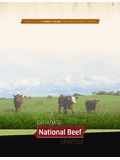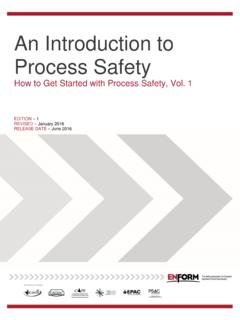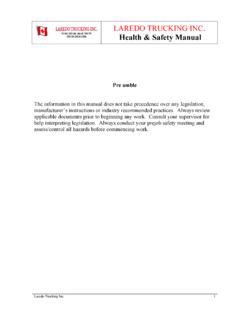Transcription of CANADA’S NATIONAL BEEF STRATEGY
1 Summary of goals , Focus Areas and Key Outcomes 2015 - 2020 Vision A dynamic profitable Canadian cattle and beef industryMission To be the most trusted and competitive high quality beef cattle producer in the world recognized for our superior quality, safety , value, innovation and sustainable production and GoalsThe NATIONAL beef Strategic Plan has been developed with the aim to achieve targeted industry goals that are aligned with the industry s vision and mission under four key pillars. The pillars identify key areas of focus where industry stakeholders will work together to collectively achieve the outcomes identified. Under each focus area specific outcomes have been defined that work towards meeting the goals established by industry. The goals established are measurable benchmarks for industry to be held accountable S NATIONAL beef STRATEGYBeef DemandCompetitivenessProductivityConnect ivityConnectivity Enhance synergies within industry and connect positively with consumers, the public, government, and partner industriesProductivity Increase production efficiency by 15% by 2020 Competitiveness Reduce cost disadvantages compared to main competitors by 7% by 2020 beef Demand Increase carcass cutout value by 15% by 2020 Participating Organizations beef Cattle Research Council Canadian beef Breeds Council Canada beef Inc.
2 Canadian Cattlemen s Association NATIONAL Cattle Feeders Association British Columbia Cattlemen s Association Alberta beef Producers Saskatchewan Cattlemen s Association Manitoba beef Producers beef Farmers of Ontario Prince Edward Island Cattle Producers New Brunswick Cattle Producers Nova Scotia Cattle Producers I. beef DEMAND Increase carcass cutout value by 15%Focus Area A: Domestic & Global Marketing 1. Establish the Canadian beef Advantage (CBA) as the most recognized and loyalty-based beef program in the world2. Get the right product to the right customer every timeFocus Area B: Market Access1. Reduce non-tariff and tariff barriers in our export markets for beef , live cattle, and beef cattle genetics2. Gain equal or preferential access in key export markets for Canadian beef , live cattle, and beef cattle genetics3.
3 Eliminate remaining BSE market access restrictionsFocus Area C: Validate & Enhance the CBA1. Validate CBA attributes to identify those that are most likely to impact carcass value and beef demand in global markets2. Verify the CBA to assess the effectiveness of efforts to improve product Develop a NATIONAL Total Quality Management System to enhance the Develop new and enhanced tools to communicate the financial contribution of the quality and yield of Canadian beef cattle5. Further enhance the CBA through the development of a Supply Chain Strategy6. Research and development to improve consumer satisfaction with Canadian beef and validate the CBAF ocus Area D: Consumer Confidence 1. Enhance consumer confidence in Canadian beef across all markets2. Improve the effectiveness and reach of consumer communication3.
4 Promote the health and nutritional benefits of beef to consumers 4. Support consumer food safety education to demonstrate the effectiveness of our science based food safety system 5. Research and extension to drive the reduction of food safety incidences and improve food safety along the supply chain Focus Area E: Social License1. Enhance the public image of Canada s beef industry by emphasizing positive industry benefits, and improvements in environmental sustainability, animal health & welfare, and food safety practises2. Increase public recognition of the beef industry s direct and indirect contributions to the Canadian economy and society3. Increase public recognition of the contribution of beef production to sustainability4. Increase public understanding of beef industry animal husbandry practices and how they are held up by the beef Code of PracticeII.
5 COMPETITIVENESS Reduce cost disadvantages compared to main competitors by 7%Focus Area A: Supportive Regulatory Environment1. Advocate and uphold a scientific risk based regulatory system2. Pursue outcome based flexible alternatives to prescriptive tactic based regulations3. Pursue regulatory cooperation with major trading partners4. Advance implementation of the three pillars of Traceability within a NATIONAL system Focus Area B: Access to Competitively Priced Inputs1. Improve access to affordable skilled labor2. Improve access to competitively priced inputs including animal health products, feed grains and forages, and new technologies Focus Area C: Maintain & Enhance Research Capacity1. Establish an internship program to mentor new scientists with industry collaborators in partnership with the CYL program2.
6 Increase research capacity and programming focusing on beef quality, food safety and related attributes of the CBA3. Increase research capacity and programming focused on the breeding and production of feed sources4. Maintain feed efficiency research capacity to drive innovations to support both cow-calf and feedlot production. 5. NATIONAL food safety , antimicrobial resistance and production limiting disease surveillance programs enhanced/developed Focus Area D: Sustainability1. Support the Global and Canadian Roundtables for Sustainable Beef2. Economic Improve return on investment and long term profitability of the beef industry3. Environmental Continually improve natural resource use, validate beef production impacts, and support verifiable supply chains4. Maintain Canada s beef industry s social license to operate through validating production practices and identifying opportunities for continuous improvement in areas of public concernIII.
7 PRODUCTIVITY Increase production efficiency by 15% Focus Area A: Genetic Selection1. Improve cattle performance for desired traits; transitioning research into tools/technologies for the seedstock sector2. Improve genetic selection for non-traditional traits 3. Encourage the adoption of superior genetics in commercial herds Focus Area B: Research & Development1. Improved forage and grassland productivity2. Improved feed grain productivity and feed efficiency3. Improved animal health and welfare Focus Area C: Technology Development & Adoption1. Engage academic and research organizations to develop new technologies that will benefit the beef cattle industry 2. Ongoing industry surveillance of international and domestic research and technology transfer activities3. Increase the proportion of producers adopting new technology with reduced lag from development to adoptionFocus Area D: Enhance Information Flow1.
8 Communicate market demands along the production chain, using information technology and verification programs 2. Facilitate genetic improvement with the link to genetic, genomic and branded beef program information3. BIXS be the industry s common repository database; a minimum of 2 million calves per year in the database 4. Develop regular reporting mechanisms, improve collaboration and services provided5. Research technologies to enhance the ability to sort cattle, carcasses at line speed in packing plants, and product by qualityIV. CONNECTIVITY Enhance industry synergies, connect positively with consumers, the public, government, and partner industriesFocus Area A: Industry Communication1. Delivery of timely, concise, & effective crisis communications2. Develop a Reputation Management Strategy3.
9 Enhance industry s ability to speak with a common voice4. Increase the number of future leaders that are able to speak and advocate on behalf Canada s beef industry Focus Area B: Engage Industry Partners1. Ongoing engagement with the NATIONAL beef Strategic Planning Group (NBSPG) 2. Creation of an annual NATIONAL industry event to include multiple industry organizations3. Expand cross organizational engagement 4. Encourage greater stakeholder engagement in programs Focus Area C: Engage Government, Industry/Global Partners1. Engage government and regulatory agencies to build and maintain long-term relationships2. Participate in consumer discussions and forums to obtain feedback and provide information regarding the Canadian beef industry3. Invest in developing long-term relationships with domestic & international organizations, encouraging collaboration in areas of mutual interest






